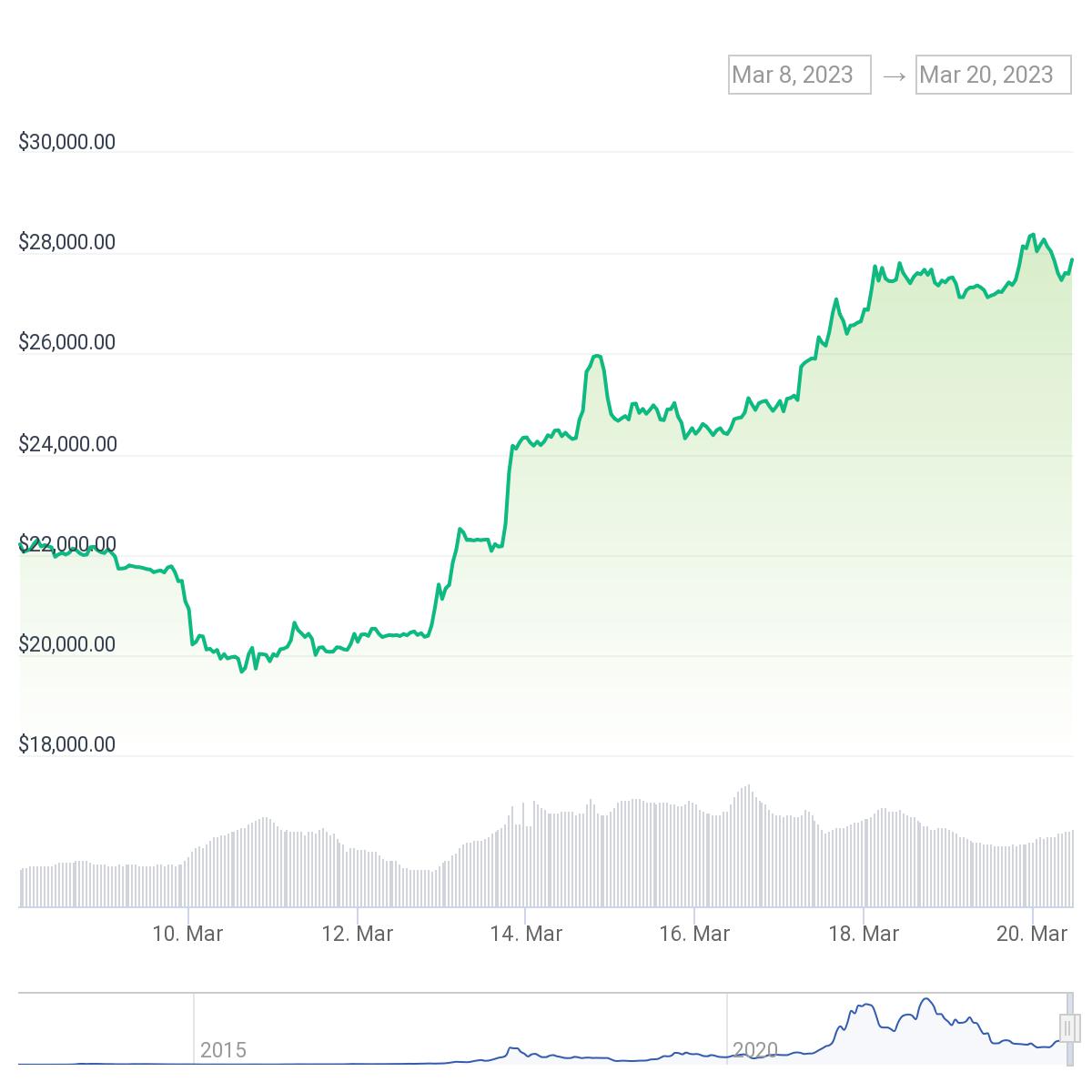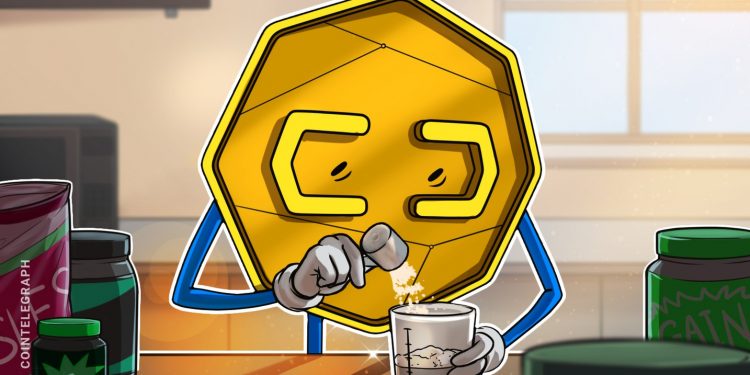USD Coin (USDC), stablecoin lớn thứ hai thế giới, có thể chỉ đơn giản là đã ở sai vị trí vào thời điểm sai.
Nơi này là Ngân hàng Silicon Valley (SVB), một ngân hàng thương mại với 209 tỷ USD tài sản, nơi mà tổ chức phát hành của USDC Circle đã gửi 3,3 tỷ USD dự trữ tiền mặt của mình để giữ an toàn.
Thời điểm là hiện tại: một trong những lãi suất tăng nhanh, trong đó các tổ chức như SVB, vốn từ lâu đã thu thập các khoản tiền gửi ngắn hạn để mua tài sản dài hạn, đã bị sụt giảm.
vài ngày đau thương, USDC mất chốt với đồng đô la Mỹ, giảm xuống mức thấp tới 0,85 USD (tùy thuộc vào sàn giao dịch) trước khi phục hồi xuống $1.00 vào thứ Hai, 13 tháng 3. Đây là đồng xu mà nhiều người coi là con áp phích cho stablecoins dựa trên fiat, tức là, minh bạch nhất, tuân thủ và thường xuyên được kiểm toán.
Một biến cố không thể đoán trước?
Timothy Massad, một nghiên cứu viên tại Trường Chính phủ Kennedy tại Đại học Harvard và cựu chủ tịch Ủy ban Giao dịch Tương lai Hàng hóa Hoa Kỳ (CFTC), nói với Cointelegraph. “Nhưng đó là một vấn đề tạm thời, không phải là dấu hiệu của sự yếu kém thiết kế cơ bản,” ông nói thêm.
Tuy nhiên, một depegging vẫn là một vấn đề nghiêm trọng. “Khi một stablecoin mất chốt của nó, nó đánh bại mục đích của sự tồn tại của nó – để cung cấp sự ổn định của giá trị giữa các thế giới crypto và fiat”, Buvaneshwaran Venugopal, trợ lý giáo sư trong khoa tài chính của Đại học Central Florida, nói với Cointelegraph. Một depegging unnerves hiện có và sẽ là nhà đầu tư, và nó không được coi là tốt cho việc áp dụng crypto.
Một số người xem đây là một sự kiện ngoại thường. Sau khi tất cả, lần cuối cùng một ngân hàng bảo hiểm tiền gửi Liên bang (FDIC) -ngân hàng lớn như SVB sụp đổ là Washington Mutual trở lại trong 2008.
Arvin Abraham, một đối tác có trụ sở tại Vương quốc Anh tại công ty luật McDermott Will và Emery, nói với Cointelegraph: “Đối với một cuộc chạy ngân hàng như thế này đã xảy ra sẽ rất khó khăn cho nhiều người – cho đến khi cuộc chạy ngân hàng xảy ra. “Một phần của vấn đề là các đối tác ngân hàng cho không gian crypto có xu hướng là một số ngân hàng rủi ro nhất. Circle có thể không có lựa chọn tại một số ngân hàng lớn hơn với cấu hình an toàn hơn.”
Hậu quả lâu dài
Việc giải quyết vấn đề đặt ra một loạt các câu hỏi về USDC và stablecoins – và ngành công nghiệp cryptocurrency và blockchain rộng hơn.
StableCoin có trụ sở tại Mỹ sẽ mất đất cho lãnh đạo ngành công nghiệp Tether (USDT), một đồng tiền ngoài khơi giữ chốt đồng đô la trong cuộc khủng hoảng?
Việc phá hủy của USDC là một tình huống “một lần”, hay nó đã tiết lộ những sai sót cơ bản trong mô hình stablecoin?
Gần đây: AI được hưởng lợi từ cơ sở hạ tầng dữ liệu dựa trên blockchain
Bitcoin (BTC), Ether (ETH) và một số tiền điện tử khác có thể hiện khả năng phục hồi trong cuộc khủng hoảng ngân hàng trong khi một số ngân hàng và stablecoin bị suy giảm? Và, những gì có thể được thực hiện hơn để đảm bảo rằng các depeggings khác không xảy ra trong tương lai?
“Một số người sẽ chỉ ra điều này như là một lý do để không khuyến khích sự phát triển của stablecoins, trong khi những người khác sẽ nói rằng các lỗ hổng của các ngân hàng lớn là chính xác lý do tại sao chúng ta cần stablecoins,” Massad nói thêm. Không phải là thực sự chính xác trong quan điểm của ông. Điều cần thiết là quy định ngân hàng toàn diện và stablecoin.
Các nhà đầu tư có thể mất niềm tin vào cả USDC và toàn bộ khu vực stablecoin trong ngắn hạn, ông Abraham cho biết, “nhưng về lâu dài, tôi không nghĩ rằng điều này sẽ có tác động đáng kể.” Tuy nhiên, tình hình nhấn mạnh “quản lý kho bạc” kém trên một phần của Circle, đề nghị Abraham, thêm:
“Giữ gần 10% tổng dự trữ trong một ngân hàng không được xem là ‘quá lớn để thất bại ‘là một động thái mạo hiểm đối với bất kỳ doanh nghiệp nào, hãy nói đến việc duy trì một chốt ổn định với đồng đô la.”
đó nói lên, Abraham hy vọng Circle sẽ học hỏi từ kinh nghiệm này và cuối cùng nổi lên mạnh mẽ hơn bao giờ hết. “Sự sợ hãi này có thể sẽ khiến Circle lùi lại một bước và suy nghĩ về việc kiểm soát tốt hơn để viện, vì vậy nó không phải chịu rủi ro đối tác cực đoan một lần nữa. Nó sẽ làm cho USDC, đã là một sản phẩm tuyệt vời, thậm chí còn an toàn hơn.”
USDC was never really in any existential danger, in Abraham’s view. Even if the U.S. government had not stepped in to “back-stop” depositors, “USDC would have been fine as its deposits were already in the process of being transferred out prior to the FDIC receivership being initiated.” The billions in reserves held by SVB would have settled in another bank by March 13 in any event, Abraham said.
Bitcoin và Ether cho thấy sự mạnh mẽ
The good news is that Circle survived, and crypto pillars like Bitcoin and Ether held up surprisingly well while the banking contagion spread to other institutions like Signature Bank, First Republic Bank and Credit Suisse.
“Is anyone else surprised that a top Stablecoin [USDC] could just depeg by ~10% instantly, with virtually no ripple effects across other coin prices? Especially since this is pretty core to a lot of DeFi trading,” tweeted Joe Weisenthal. ARK Invest’s Cathie Wood even celebrated cryptocurrencies as a safe haven during the banking crisis.
Others, though, were more measured. BTC and ETH began to fall on March 10 and the early part of that weekend, noted Abraham. “If the U.S. government had not stepped in to backstop depositors in the U.S., and HSBC had not bought the U.K. bank, there would likely have been significant pain across the crypto sector when the markets opened again on Monday [March 13].”

Others suggested that USDC basically did everything right; it was just unlucky. “USDC reserves are pretty much made up of cash and short-dated securities, with 80% held in the latter, probably the safest asset out there,” Vijay Ayyar, vice president of corporate development and global expansion at Luno, told Cointelegraph. “Hence, USDC in itself has no real issues if one takes a deeper look at what transpired.”
In Ayyar’s view, the more urgent need is “to have a full reserve dollar digital system that helps us move away from the systemic risks in the current fractional system.”
What does this mean for stablecoins?
What does this decoupling signify for stablecoins in general? Does it prove that they’re not really stable, or was this a one-off event where USDC happened to find itself in the wrong Federal Reserve-member bank? One lesson arguably learned is that stablecoin survivability isn’t entirely about reserves. Counterparty risk also has to be considered.
“Fiat-backed stablecoins have a number of intersecting risk factors,” Ryan Clements, assistant professor at the University of Calgary Faculty of Law, told Cointelegraph, further explaining:
“Much of the discussion to date on the risks of fiat-backed coins like USDC has focused on the issue of reserve composition, quality and liquidity. This is a material concern. Yet it is not the only concern.”
During the current crisis, many people were surprised “at the extent of the duration mismatch and lack of interest rate hedges at SVB, as well as the extent of Circle’s exposure to this bank,” said Clements.
Other factors that can unhinge a stablecoin are issuer insolvency and reserve custodian insolvency, said Clements. Investor perceptions also have to be considered — especially in the age of social media. Recent events demonstrated “how investor fears of reserve custodian insolvency can catalyze a depegging event due to a redemption run against the stablecoin issuer and a sell-off of the stablecoin on secondary crypto-asset trading platforms,” he added.
As the University of Central Florida’s Venugopal earlier said, depeggings erode the confidence of new investors and potential investors sitting on the fence. “This further delays the widespread adoption of decentralized financial applications,” said Venugopal, adding:
“The one good thing is that such mishaps bring in more scrutiny from the investor community — and regulators if the ripple effects are large enough.”
Wherefore Tether?
What about USDT, with its peg holding steady throughout the crisis? Has Tether put some distance between itself and USDC in the quest for stablecoin primacy? If so, isn’t that ironic, given Tether has been accused of a lack of transparency compared with USDC?
“Tether has also had its share of questions raised previously with regard to providing audits on its holdings, which has resulted in a depeg previously,” said Luno’s Ayyar. “Hence, I don’t think this incident proves that one is stronger than the other in any way.”
“The crypto markets have always been rich in irony,” Kelvin Low, a law professor at the National University of Singapore, told Cointelegraph. “For an ecosystem that is touted to be decentralized by design, much of the market is centralized and highly intermediated. Tether only appears to be stronger than USDC because all of its flaws are hidden from view.” But flaws can only be hidden for so long, Low added, “as the FTX saga demonstrates.”
Still, after dodging a bullet last week, USDC may want to do things differently. “I suspect that USDC will seek to strengthen its operations by diversifying its reserve custodian base, holding its reserves at a larger bank with stronger duration risk management measures and interest rate hedges, and/or ensuring that all reserves are adequately covered by FDIC insurance,” said the University of Calgary’s Clements.
Lessons learned
Are there any more general insights that can be drawn from recent events? “There’s no such thing as a completely stable stablecoin, and SVB perfectly illustrates that,” answered Abraham, who, like some others, still views USDC as the most stable of stablecoins. Still, he added:
“For it [USDC] to go through a 10% depegging event shows the limitations of the stablecoin asset class as a whole.”
Moving forward, “It will also be very important for stablecoin investor transparency to continually know what proportion of reserves are held at which banks,” said Clements.
Low, a crypto skeptic, said that recent events demonstrated that no matter what their design, “all stablecoins are susceptible to risks, with algorithmic stablecoins perhaps the most problematic. But even fiat-backed stablecoins are also susceptible to risk — in this case, counterparty risk.”
Also, stablecoins “are still subject to the risk of loss of confidence.” This applies to cryptocurrencies like Bitcoin, too; even though BTC has no counterparty risk or depegging issues, continued Low. “Bitcoin prices are [still] susceptible to downside pressures when there is a loss of confidence in the same.”
Recent: Silicon Valley Bank’s downfall has many causes, but crypto isn’t one
Ayyar stated that USDC already had diverse banking partners, with only 8% of its assets at SVB. “Hence, that in itself is not the solution.” One needs to think more long-term, he suggested, including implementing comprehensive consumer protections “as opposed to relying on the current patchwork approach.”
As for former CFTC chief Massad, he cited the need for reforming both stablecoins and banking, telling Cointelegraph:
“We need a regulatory framework for stablecoins, as well as an improvement in the regulation of mid-size banks — which may require a strengthening of the regulations, better supervision, or both.”

























